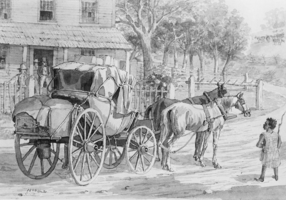
Few reliable overland routes reached into the mountains of Western Virginia at the close of the Revolutionary era. The Virginia legislature authorized a series of roads in the 1780s, but most were neither paved nor maintained. Although public officials recognized the need for comprehensive internal improvements, poor construction techniques and difficult terrain made for slow and treacherous overland travel.
In 1808, U.S. Secretary of the Treasury Albert Gallatin outlined a national transportation plan featuring turnpikes, canals, and river improvements. After Congress failed to adopt it, individual states assumed responsibility for their own transportation improvements. The Virginia General Assembly in 1816 passed an act to establish an internal improvement fund and a Board of Public Works to charter turnpike companies. Under the board’s authority, the state financed 40 percent to 60 percent of the cost for turnpikes, and private stockholders paid the rest. Varying rates of tolls were assessed, based on the size of vehicles or the number of livestock being driven, with the charges used to defray maintenance costs and, in some cases, turn a profit for investors. In reality, few stockholders expected to make money (and few did), as most settled instead for the indirect benefits of having a road linking them with outside markets.
By 1850, West Virginia had dozens of turnpikes of varying width, length, and construction, and four principal east-west routes. The National Road from Cumberland, Maryland, to Wheeling opened in 1818, while the James River & Kanawha Turnpike was completed in 1832 from Greenbrier County to the mouth of the Big Sandy River. Completed in 1838 between Winchester and Parkersburg, the Northwestern Virginia Turnpike followed a superb line over the mountains as planned and laid out by Virginia’s chief engineer, Claudius Crozet. An engineering marvel, the road opened up large sections of Western Virginia to settlement and commerce. The last of the major east-west turnpikes, the Staunton-Parkersburg, was completed in 1847. These and other turnpikes proved vital to Union and Confederate forces during the Civil War, and many clashes ensued in the struggle for their control. Shorter north to south turnpikes often provided important connections with the primary east-west thoroughfares. These included the Giles, Fayette & Kanawha Turnpike, completed from Pearisburg, Virginia, to Kanawha Falls in 1848, and the Weston & Gauley Bridge Turnpike, opened in 1858.
Despite Virginia’s ambitious effort, residents beyond the mountains felt the state did not fairly allocate transportation improvements. This issue contributed to east-west sectional differences and loomed large during the statehood crisis. Western Virginia did lag behind the east in railroad construction, but records indicate that 94 of the 162 state-chartered road and turnpike companies existing in 1859 operated wholly or partly in present West Virginia. The Old Dominion chartered six new western turnpikes in 1860, but did not build any before the Civil War began.
When Virginia’s turnpike era ended, the state had invested $4.8 million in 6,390 miles of toll roads. West Virginia inherited many of these routes in 1863, but the Civil War took a heavy toll on the roadways and bridges. Still, the legislature chartered 38 additional turnpike companies between 1863 and 1872. Spurred on by the incredible growth of railroads, highway traffic eventually declined, toll revenues fell off, and routes faded into oblivion or devolved into locally maintained haul roads in the late 1800s. In the automobile age many of the old turnpike routes have been revived as major secondary or interstate highways, including U.S. 60, U.S. 50, U.S. 250, and parts of Interstates 64 and 79.
In 1954, the West Virginia Turnpike opened from Charleston to Princeton, the modern successor to the great turnpikes of the century before. This two-lane toll road became the state’s first high-speed expressway and ushered in a new highway era. Development of the interstate and Appalachian Corridor systems created new and faster routes through West Virginia, but the historic 19th-century turnpikes remain the basis for much of the state’s existing road network.
This Article was written by Billy Joe Peyton
Last Revised on December 19, 2017
Related Articles
Sources
Peyton, Billy Joe. To Make the Crooked Ways Straight and the Rough Ways Smooth: Surveying and Building America's First Interstate Highway. American Civil Engineering History, (2002).
Hunter, Robert F. "The Turnpike Movement in Virginia, 1816-1860." Ph.D. diss., Columbia University, 1957.
Cite This Article
Peyton, Billy Joe "Turnpikes." e-WV: The West Virginia Encyclopedia. 19 December 2017. Web. 26 July 2024.


Comments?
There aren't any comments for this article yet.
Click here to read and contribute to the discussion →